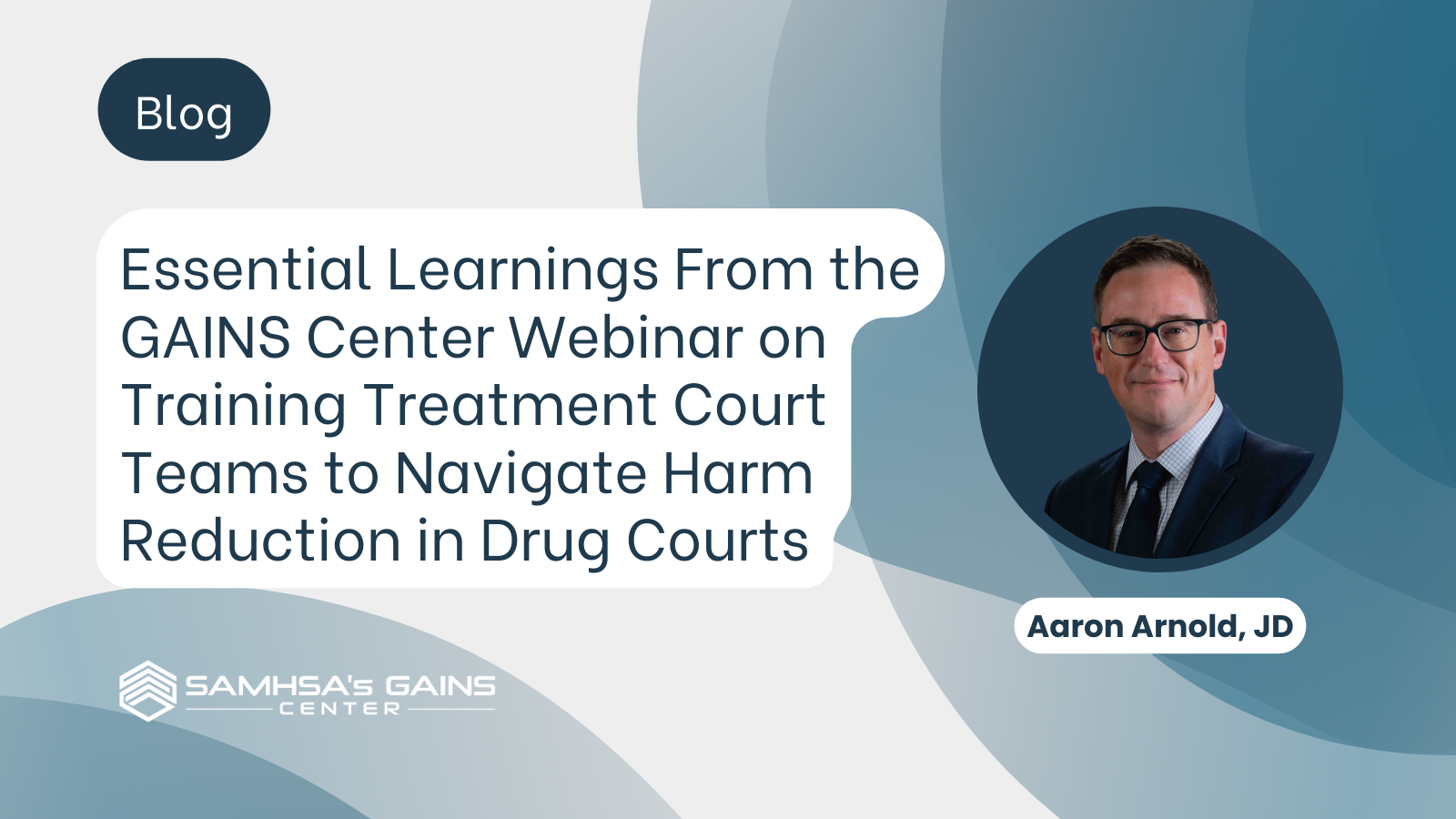Harm reduction in drug courts is a crucial approach to supporting individuals with substance use disorders who become involved in the criminal legal system. Harm reduction aims to minimize the negative impacts of drug use and enhance public health and safety. SAMHSA’s GAINS Center’s recent webinar, “Training Treatment Court Teams: Navigating Harm Reduction in Drug Courts,” builds on previous discussions about harm reduction practices, focusing on their practical application in treatment court settings and the roles of various team members. Read on to learn how this approach makes an impact.
Q: What is harm reduction, and why is it important in drug courts?
A: Harm reduction is a set of practical strategies aimed at reducing the negative consequences associated with drug use. In drug courts, it is crucial because it addresses the health and safety of individuals without requiring abstinence, which can be a more realistic and compassionate approach to supporting recovery.
Q: How can treatment courts integrate harm reduction practices effectively?
A: Integration involves understanding and applying harm reduction principles, such as providing access to naloxone; normalizing medication-assisted treatment (MAT) across staff, participants, and their families; and using non-punitive responses to returns to substance use. Training court teams on these practices ensures that all members understand and support the harm reduction approach.
Q: What role do judges play in supporting harm reduction in drug courts?
A: Judges can foster a supportive environment by endorsing harm reduction strategies and encouraging their use in the courtroom. They play a pivotal role in setting the tone and expectations for the court’s approach to substance use and recovery, promoting a non-punitive, supportive atmosphere.
Q: How can court coordinators facilitate the implementation of harm reduction practices?
A: Court coordinators can ensure that harm reduction strategies are incorporated into the court’s policies and procedures. They can also organize training for team members, coordinate with community partners to provide resources, and monitor the effectiveness of harm reduction interventions.
Q: What is the significance of medication for opioid use disorders (MOUD) in harm reduction?
A: Medications for opioid use disorder include three FDA-approved medications—methadone, buprenorphine, and naltrexone—that are the basic standard of care for moderate to severe OUD. It is a critical component of harm reduction because it helps manage withdrawal symptoms and cravings, reducing the risk of resumption of substance use and supporting long-term recovery.
Q: How can probation officers support harm reduction efforts in drug courts?
A: Probation officers can adopt a supportive, rather than punitive, approach to supervision. They can connect clients with harm reduction resources, encourage adherence to MOUD, and use instances of returns to substance use as an opportunity for intervention and support rather than punishment.
Q: What resources are available on the topic of harm reduction practices for treatment court teams?
A: Resources that can help treatment court teams learn about and integrate harm reduction practices include the publications Adult Treatment Court Best Practice Standards from All Rise, SAMHSA’s Harm Reduction Framework, and Principles of Harm Reduction from the National Harm Reduction Coalition, and the webinar “Harm Reduction Strategies in Treatment Court: What Fits and What Doesn’t” and article “A Primer on Harm Reduction in Treatment Courts” from SAMHSA’s GAINS Center.
Q: How can treatment court teams measure the success of harm reduction initiatives?
A: Success can be measured by tracking metrics such as reduced rates of resumption of substance use, improved health outcomes, and increased engagement in treatment. Regularly reviewing these metrics helps teams adjust their strategies and ensure they are meeting the needs of participants.
Q: What challenges might treatment court teams face when implementing harm reduction, and how can they be addressed?
A: Challenges include hesitance about change, limited resources, and stigma associated with harm reduction. These can be addressed through ongoing education, securing funding for resources, and fostering a culture of empathy and support within the court team.
Q: How can collaboration with community partners enhance harm reduction efforts in drug courts?
A: Collaboration with community organizations, healthcare providers, and harm reduction programs can provide additional resources and support for participants. These partnerships can enhance the comprehensive care offered by the court and improve outcomes for individuals.
For more in-depth insights and practical strategies, watch the full webinar below.


